Predeceased “Heirs”: Becoming an Heir by Right of Representation
- Becoming an Heir by Right of Representation
- Examples of Heirs, Taking by Right of Representation, and Respective Shares
- Distribution Per Capita
A. Becoming an Heir by Right of Representation
Caution: Predeceased “heirs.” An obvious heir (eg, a child of the Decedent) has predeceased the Decedent. What happens to the predeceased “heir’s” share?
The pertinent statute is RCW 11.02.005(3), which provides as follows:
| (3) “Representation” refers to a method of determining distribution in which the takers are in unequal degrees of kinship with respect to the intestate, and is accomplished as follows: After first determining who, of those entitled to share in the estate, are in the nearest degree of kinship, the estate is divided into equal shares, the number of shares being the sum of the number of persons who survive the intestate who are in the nearest degree of kinship and the number of persons in the same degree of kinship who died before the intestate but who left issue surviving the intestate; each share of a deceased person in the nearest degree shall be divided among those of the deceased person’s issue who survive the intestate and have no ancestor then living who is in the line of relationship between them and the intestate, those more remote in degree taking together the share which their ancestor would have taken had he or she survived the intestate. Posthumous children are considered as living at the death of their parent. |
This website’s glossary describes “by right of representation” and “issue” as follows:
| BY RIGHT OF REPRESENTATION (aka PER STIRPES DISTRIBUTION) | |
| A distribution of property that passes such that any property that would otherwise pass to a predeceased heir or beneficiary is distributed instead to his/her then living issue, equally if in the same generation. Contrast: PER CAPITA DISTRIBUTION. | |
| ISSUE | |
| The class of individuals descending from a common ancestor, ie, children, grandchildren, great-grandchildren, etc. Compare: DESCENDANT. | |
B. Examples of Heirs, Taking by Right of Representation, and Respective Shares
Examples to illustrate the determination of heirs and taking by right of representation —
Hypothetical Situation 1:
- George Washington, a resident of Washington, never got around to making a Will.
- >George’s family consists of his wife, Martha, and his only children, John and Susan, born of his only marriage.
- “>John has never married or had any children.
- Susan married Abraham and had one child, Barbara.
A genealogical chart of George and Martha’s extended family for Hypothetical Situation 1 looks like:
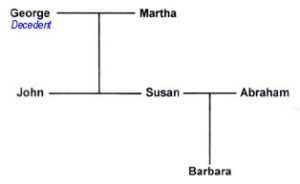
- Alternative (a): George dies having only community property.
With only community property, surviving spouse Martha is the only heir:- Martha takes all the estate.
- Alternative (b): George dies having only separate property.
With only separate property, surviving spouse Martha is one heir & takes one-half of the estate; surviving children John and Susan are also heirs, who collectively take the remaining one-half of the estate in equal shares:- Martha takes 1/2
- John takes 1/4
- Susan takes 1/4.
- Alternative (c): Susan predeceases, then George dies having only separate property.
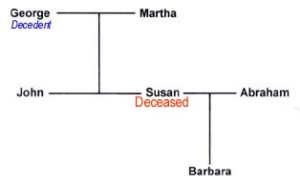
Same result as in Alternative (b) but Susan’s child “stands in her shoes,” becomes an heir, and takes “by right of representation” what Susan would have taken had she been alive:
- Martha takes 1/2
- John takes 1/4
- Susan’s child takes Susan’s 1/4:
- Barbara takes 1/4
Hypothetical Situation 2:
- Same initial situation as Hypothetical Situation 1 above:
- George Washington, a resident of Washington, never got around to making a Will.
- George’s family consists of his wife, Martha, and his only children, John and Susan, born of his only marriage.
- John has never married or had any children.
- Mary married and had only one child, Barbara.
- Years pass, during which time:
- Martha predeceases,
- George never remarries,
- Susan has a second child, a son, Robert
- John adopts a son, Gerald, and
- Barbara marries and has three children (Tom, Dick, and Harry).
A genealogical chart of George and Martha’s extended family for Hypothetical Situation 2 looks like:

- Alternative (d): George dies having only separate property.
Same result as in Alternative (b) but with Martha, having predeceased, taking nothing:
- John takes 1/2
- Susan takes 1/2
- Alternative (e): Susan predeceases, then George dies having only separate property.
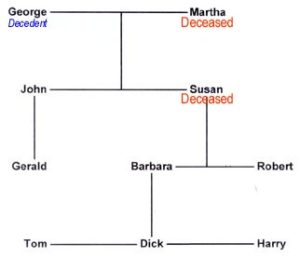
Same result as in Alternative (d) but Susan’s children “stand in her shoes,” become heirs, and take “by right of representation” what Susan would have taken had she been alive:
- John takes 1/2
- Susan’s children collectively take Susan’s 1/2 in equal shares:
- Barbara takes 1/4
- Robert takes 1/4
- Alternative (f): Susan and Barbara both predecease, then George dies having only separate property.
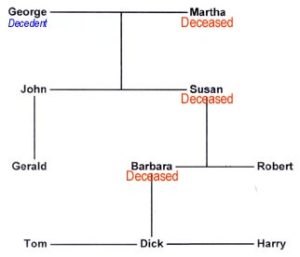
Same result as in Alternative (e) but Barbara’s children “stand in her shoes,” become heirs, and take “by right of representation” what Barbara would have taken had he been alive:
- John takes 1/2
- Susan’s children and lower issue collectively take her share: 1/2
- Robert takes his half of Susan’s share: 1/4
- Tom, Dick, and Harry collectively take Barbara’s half of Susan’s share: 1/4 in equal shares
- Each of Tom, Dick, and Harry takes 1/3 of 1/4 = 1/12
- Alternative (g): Susan, Barbara, and John all predecease, then George dies having only separate property.
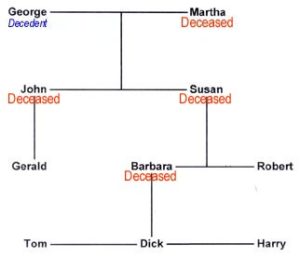
Alternative (g) illustrates one of the peculiarities of Washington law, namely, that Washington law begins counting heirs at the closest level of kinship having surviving heirs (whether or not by right of representation). In Alternative (f), George was survived by a child, John, so there, Washington law begins counting heirs at the child level, with the result that John took half of the estate. In Alternative (g), George is survived not by a child, but only by grandchildren (and lower issue) — so here, Washington law now begins counting heirs at the grandchild level, with the result being three heirs (two living grandchildren + one deceased grandchild leaving now living children) at that level by right of representation —
- Gerald takes 1/3
- Robert takes 1/3
- Barbara’s children collectively take her share: 1/3 in equal shares
- Each of Tom, Dick, and Harry takes 1/3 of 1/3 = 1/9
Notice that here, as a result of John’s share going to his child and eliminating the last taker at the child level, the shares of the grandchildren increase (from 1/4 to 1/3), as do those of the great-grandchildren (from 1/12 to 1/9). Such are the vagaries of probate law.
Bottom-line:
- Heirs include those who take “by right of representation” — the surviving children (and possibly lower issue) of a predeceased child who would have been an heir and taken had the predeceased child survived the Decedent; and
- When sending Notice (eg, of a hearing or of your appointment) to heirs, you are required to send Notice to all heirs, including those who have become heirs by right of representation.
Recommendation: For your sake as the Personal Representative as well as for the benefit of the eventual takers of the estate:
This means, for example, sending notice to all:
regardless of what you believe to be true as to |
C. Distribution Per Capita
A different method of distribution is “distribution per capita” — meaning that the property is distributed to all the takers in equal shares, regardless of level of kinship. Had George specified in his Will that his property was to be distributed “to my heirs per capita” (the equivalent of “to my heirs in equal shares”), then the identity of his heirs would be determined under Washington law and be as specified above, but each would take an equal share according to the terms of his Will.